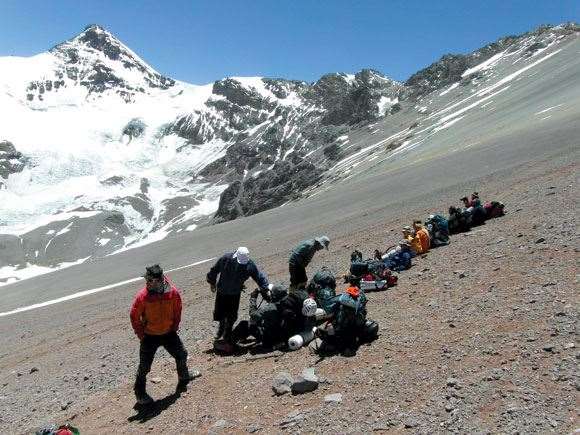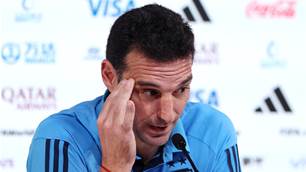Climbing a high mountain produces scant adrenaline and offers little in the way of thrills. Instead it’s all about discomfort;
 photos by AARON SCOTT
photos by AARON SCOTTThree years after Gussfeldt’s failed shot at Aconcagua’s summit, the Englishman Edward FitzGerald had a crack. His research was impeccable, his organisation meticulous. Following a route similar to the German, FitzGerald moved steadily up the western face of the mountain before establishing a high camp at 6000m. Time and again, he set out from this camp, only to be driven back by the wind, the cold, and his own failing limbs. Finally, his second-in-command, a Swiss called Matthias Zurbriggen, broke ranks and pushed to the summit alone. While Zurbriggen buried his axe on the summit, FitzGerald wallowed in his defeat. “There is no telling how far a man can go,” he wrote in his diary. “Sometimes and for no apparent reason, it is just impossible to go on walking.” When I read this line from FitzGerald’s diary, in the relative opulence of base camp, I was dubious. Surely, with the summit in sight, you could always go on walking? Surely you could keep moving, one foot in front of the other ...
Our summit day begins at four in the morning when Martin gives the call for boiled water. The night is black as ink, the wind is steady, and the cold is something that can’t be put in words. We leave camp at 5:30 sharp. We have to be fully dressed, our packs loaded with helmet, crampons, food. Water will freeze in minutes in our packs, so bottles have to be zipped beneath our down jackets; cameras will freeze even more quickly, so they have to be zipped a layer below the water. Every movement is an ordeal. The smallest act – pulling my boots on, tying my shoe laces, zipping my down jacket – sends me into a breathless crouch.
At 5:30 we gather in the silvery light, our headlamps tracking crazy shapes on the ground. Martin yells his final pep-talk into the wind. “This is the mountain you chose to climb, okay? This is what you came to do. Remember what I said: today is all about the mind.” And then we’re off, in line, at pace, the wind in our faces. I fix my eyes on the boots in front of me and focus on my breathing, in through the nose, out through the mouth. At some point the sun rises. I’m alarmed to find myself in sunlight. I reach to turn off my headlamp and find the battery’s gone dead anyway. I look around at the climbers behind me. Blank ski goggles stare back.
I find I’m forgetting to breathe. A climber above turns and heads back down the mountain. I look at his face as he goes past. Blank goggles stare back. A burning in my lungs tells me I’ve forgotten to breathe again ...
This is how summit day goes. Snatches of lucidity broken by spells of dreamlike action and longer spells of absolute nothingness. I stare at the boots in front of me and concentrate on breathing. It’s all my brain can handle. I see climbers turning and going back. Traversing across a steep pitch of ice-covered scree, Martin tells us to put our crampons on. My hands are useless, my mind dense. It takes me ten minutes to get them out of their zippered bag. It takes me another ten minutes to work the strap through its clasps. After I’ve finally fixed them to my boots I stand, take three steps, and find my right crampon has fallen off. I collapse on a rock and consider weeping.
The final stretch to the summit is a precipitous giants-ladder of jagged rock chunks. It’s here, our group whittled down to a party of five climbers and Martin, that the weather turns. I’m bewildered to find the air about my face grey, flecks of ice hitting my bare cheeks. I’d ask what’s happening, but the wind sweeps conversation away. I look about at our group and find blank ski goggles staring back at me. I focus on the boots in front of me and concentrate on my breathing. But I can’t get the order right. I stumble and find my chest trembling for want of wind. It goes on like this for some amount of time.
Then I find that FitzGerald was right: “Sometimes, and for no apparent reason, it is just impossible to go on walking.” The summit is 60m above me, in plain view through the wind-driven waves of snow, when my body stops working. It’s an astonishing realisation. My legs won’t put my feet where I want them. My feet won’t rest squarely on the ground. I fall. I fall again. I stop, take five deep breaths, channel all my energies, and fall again. Somewhere in my mind I think, “This is what it must feel like to drink a bottle of scotch in a dozen swigs.” I’m in the process of getting to my feet when I fall again. With the other three guides already back down the mountain, Martin shrugs. “Okay, we all turn around.” If I knew what was happening, I might’ve argued.
I can’t remember much from that point on. Apparently the temperature dropped to 30 below. Apparently I was talking gibberish. Apparently I got a shot of adrenaline in my right butt cheek before being tethered to a 20m length of rope and guided down the mountain like a broken mule. Sounds likely. All I know for certain is that if a guide wasn’t up there with me, I would have sat down ona rock and quietly expired, the summit a few dozen metres above me.
The real questions – as my mother asked when she read the first draft of this story – are: why would anyone do this? Where’s the enjoyment? These aren’t easy questions to answer, but I’ll try. Put yourself on the side of a mountain, a huge upward sweep of scree surrounded by a jagged blanket of snow-covered peaks. Take a step, pause, breathe. Take another step. Pause again. Breathe again. This is your pace, moving up the side of the mountain in the tiniest of accretions, the slowest of steps, your boots creaking, your poles chinking on shards of rock. It’s a rare pleasure to concentrate so completely on something as elementary as walking, breathing. Distractions disappear. Time melts away. The views grow wider with each step. It’s a thing of rare beauty. Believe me.
 photos by AARON SCOTT
photos by AARON SCOTT‒ Aaron Scott
Related Articles

Socceroos coach says Argentina can only 'play two ways'

Argentina coach on 'inferior' Socceroos: 'I don't fully agree'













